= Echinopsis jajoiana (Backeb.) hort. ex R.Blossfeld
= Echinopsis jajoiana (Backeberg ) R.Blossfeld - Kakteensamen, 16 [1938], nomen subnudum.
Accepted Scientific Name: Echinopsis marsoneri Werderm.
Repert. Spec. Nov. Regni Veg. 30: 55; et in Repert. Spec. Nov. Regni Veg. Sonderbeih. C, t. 26 (1932).
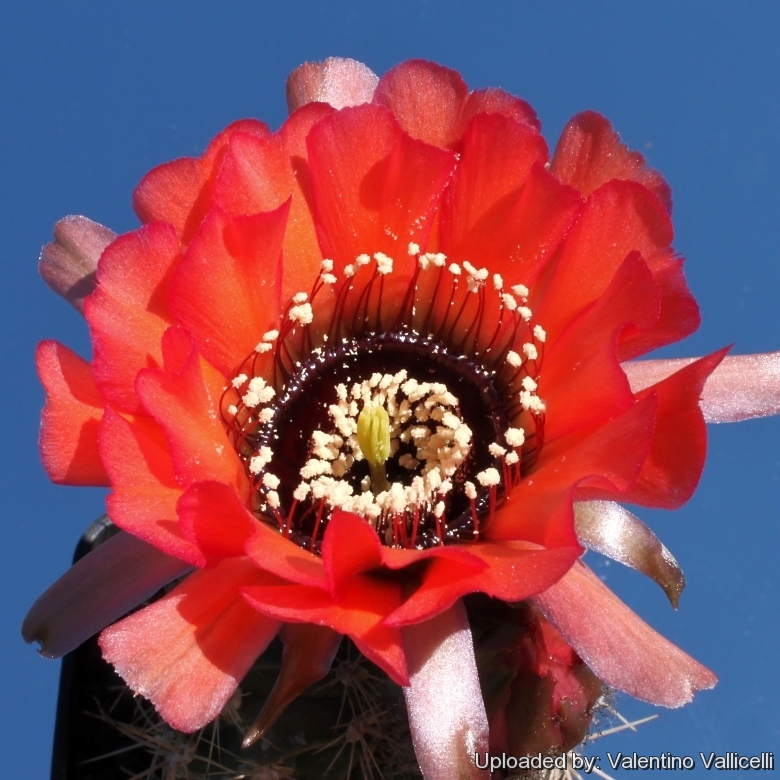
Lobivia chrysantha var. jajoiana (Echinopsis jajoiana) Photo by: Valentino Vallicelli
Origin and Habitat: Echinopsis jajoianaSN|11361]]SN|11361]] has a relatively restricted range in North Argentina (Province of Salta and Jujuy)
Altitude: It grows at around 2200 to 4100 metres in altitude.
Habitat and Ecology: This species grows in rocky areas in the altiplano together with Rebutia euanthemaSN|4970]]SN|4400]], Lobivia sublimifloraSN|12549]]SN|12549]] and Rebutia pseudodeminutaSN|4400]]SN|4970]]. It is quite common where it occurs and not subject to any major threat.
Synonyms:
See all synonyms of Echinopsis marsoneri
back
Accepted name in llifle Database:Echinopsis marsoneri Werderm.Repert. Spec. Nov. Regni Veg. 30: 55; et in Repert. Spec. Nov. Regni Veg. Sonderbeih. C, t. 26 (1932).Synonymy: 53
Cultivars
(1):
back
Description: Echinopsis jajoianaSN|11361]]SN|11361]] best knowns as Lobivia jajoianaSN|4662]]SN|4662]] is a very popular small cactus priced for its multicoloured flowers, comprising yellow, orange vine-red and violet. All of them have in common that the hymen (or throat ring of the flower) is always of a very dark purple-violet to black, thickened at the edge and glossy. It grows solitary or in groups.
Stem: Soft, about 5 to 7 cm across, gray-green to dark green, at first spherical, egg-shaped, then elongate as they ages. The crown is slightly depressed and covered with whitish wool.
Ribs: 10-14, compressed, running downward and divided into slanting tubercles whose arrangement creates the impression of a wavy line.
Areoles: 3 mm across, with grey-white felt.
Spines: Of different length, usually straight or slightly bent, directed upward, dark brown to blackish in youth, later grey.
Radial spines: Approximately 10 or less, about 1 cm long.
Central spines: 1 to 3, strong, dark, frequently red; the upper spine usually attains a length of 3 cm and is often hooked and thickened basally (but sometime the longest of them may reach the length of 4-6 cm).
Root: Thick taproot.
Flowers: Arising from the basal tubercles on the side of the plant, up to 7 cm wide, their colors is very variable, going from yellow to orange, tomato-red, vine-red and also happening through all the imaginable tones of violet. All of them have in common that the hymen (or throat ring of the flower) is always of a very dark purple-violet to black, thickened at the edge and glossy. The stamens are purple, the anthers yellow.
Subspecies, varieties, forms and cultivars of plants belonging to the Echinopsis marsoneri group
 Echinopsis jajoiana (Backeb.) hort. ex R.Blossfeld: Flowers colors is very variable, comprising yellow, orange vine-red and violet. All of them have in common that the hymen (or throat ring of the flower) is always of a very dark purple-violet to black, thickened at the edge and glossy.
Echinopsis jajoiana (Backeb.) hort. ex R.Blossfeld: Flowers colors is very variable, comprising yellow, orange vine-red and violet. All of them have in common that the hymen (or throat ring of the flower) is always of a very dark purple-violet to black, thickened at the edge and glossy. Echinopsis jajoiana f. cristata hort.: Crested form.
Echinopsis jajoiana f. cristata hort.: Crested form. Echinopsis jajoiana cv. Anemone: Plant with Anemone like-flowers, the petals are pinkish-white with a very dark purple-violet to black contrasting throat.
Echinopsis jajoiana cv. Anemone: Plant with Anemone like-flowers, the petals are pinkish-white with a very dark purple-violet to black contrasting throat. Echinopsis marsoneri Werderm.: Flowers vary from yellow to orange, tomato-red, vine-red and also happening through all the imaginable tones of violet and have a darker contransting orange, red, brown or black throat.
Echinopsis marsoneri Werderm.: Flowers vary from yellow to orange, tomato-red, vine-red and also happening through all the imaginable tones of violet and have a darker contransting orange, red, brown or black throat. Lobivia jajoiana var. aurata Rausch: has globose-spherical stems up to 50 mm in diameter and often violet tinged. Ribs 11, radial spines 2-3(-4), central spines 0-1. Flowers golden to orange, with a purple-violet to black throat. Distribution: Jujuy, Punta Corral.
Lobivia jajoiana var. aurata Rausch: has globose-spherical stems up to 50 mm in diameter and often violet tinged. Ribs 11, radial spines 2-3(-4), central spines 0-1. Flowers golden to orange, with a purple-violet to black throat. Distribution: Jujuy, Punta Corral. Lobivia jajoiana var. elegans Rausch: has about 16 ribs, 8-14 radials and 1 central spine. Flowers ochre orange to dark purple-red with a glossy purple-violet to black hymen. Distribution: Jujuy, west at high elevations including Tilcara.
Lobivia jajoiana var. elegans Rausch: has about 16 ribs, 8-14 radials and 1 central spine. Flowers ochre orange to dark purple-red with a glossy purple-violet to black hymen. Distribution: Jujuy, west at high elevations including Tilcara. Lobivia jajoiana var. nigrostoma (Kreuz. & Buining) Backeb.: has yellow flower with the hymen always of a very dark purple-violet to black. Spines are not hooked, needle-like, rather long and not thick. Stems are bluish-green as in the type species. Distribution: Jujuy, Argentina.
Lobivia jajoiana var. nigrostoma (Kreuz. & Buining) Backeb.: has yellow flower with the hymen always of a very dark purple-violet to black. Spines are not hooked, needle-like, rather long and not thick. Stems are bluish-green as in the type species. Distribution: Jujuy, Argentina.- Lobivia jajoiana var. paucicostata (Rausch) Rausch
- Lobivia marsoneri var. iridescens (Backeb.) Rausch: has yellow blooms with orange to red to brown throats. Distribution: Jujuy, Argentina.
Notes: It's a hopeless task to cross-pollinate long tubed Echinopsis species and Lobivia (Echinopsis) jajoiana. But nobody has yet had any success in transferring the black throat of Lobivia jajoianaSN|4662]]SN|4662]] flower to that of an Echinopsis. The attempts to produce a pure white flower with a black throat in Lobivia has also failed.
Bibliography: Major references and further lectures
1) Edward Anderson “The Cactus family” Timber Press, Incorporated, 2001
2) James Cullen, Sabina G. Knees, H. Suzanne Cubey "The European Garden Flora Flowering Plants: A Manual for the Identification of Plants Cultivated in Europe, Both Out-of-Doors and Under Glass" Cambridge University Press, 11/Aug/2011
3) David R Hunt; Nigel P Taylor; Graham Charles; International Cactaceae Systematics Group. "The New Cactus Lexicon" dh books, 2006
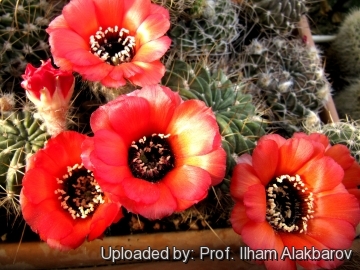 Lobivia chrysantha var. jajoiana (Echinopsis jajoiana) Photo by: Prof. Ilham Alakbarov
Lobivia chrysantha var. jajoiana (Echinopsis jajoiana) Photo by: Prof. Ilham Alakbarov Lobivia chrysantha var. jajoiana (Echinopsis jajoiana) Photo by: Viviana Alejandra Castro
Lobivia chrysantha var. jajoiana (Echinopsis jajoiana) Photo by: Viviana Alejandra Castro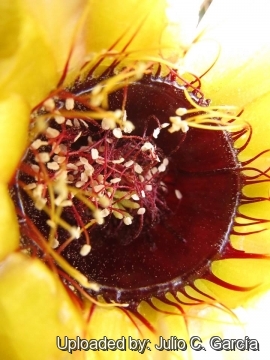 Lobivia chrysantha var. jajoiana (Echinopsis jajoiana) Photo by: Julio C. García
Lobivia chrysantha var. jajoiana (Echinopsis jajoiana) Photo by: Julio C. García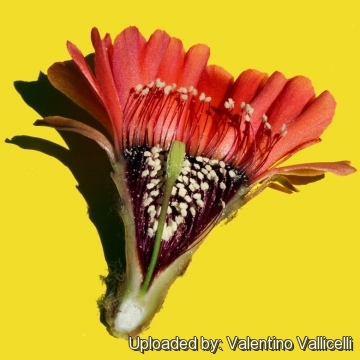 Lobivia chrysantha var. jajoiana (Echinopsis jajoiana) Photo by: Valentino Vallicelli
Lobivia chrysantha var. jajoiana (Echinopsis jajoiana) Photo by: Valentino Vallicelli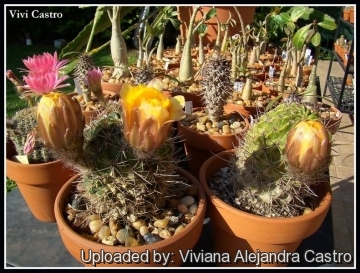 Lobivia chrysantha var. jajoiana (Echinopsis jajoiana) Photo by: Viviana Alejandra Castro
Lobivia chrysantha var. jajoiana (Echinopsis jajoiana) Photo by: Viviana Alejandra Castro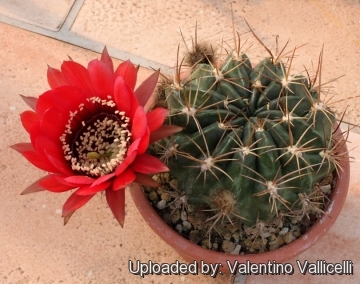 Lobivia chrysantha var. jajoiana (Echinopsis jajoiana) Photo by: Valentino Vallicelli
Lobivia chrysantha var. jajoiana (Echinopsis jajoiana) Photo by: Valentino Vallicelli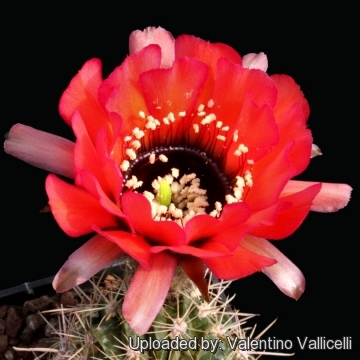 Lobivia chrysantha var. jajoiana (Echinopsis jajoiana) Photo by: Valentino Vallicelli
Lobivia chrysantha var. jajoiana (Echinopsis jajoiana) Photo by: Valentino Vallicelli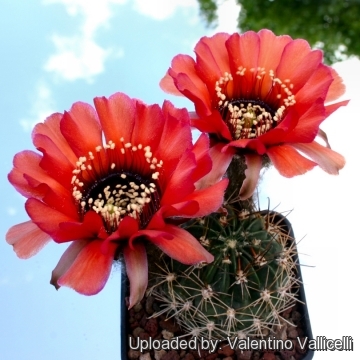 - It is probably the best species for really flashy flowers that are of a unique beauty. (Echinopsis jajoiana) Photo by: Valentino Vallicelli
- It is probably the best species for really flashy flowers that are of a unique beauty. (Echinopsis jajoiana) Photo by: Valentino VallicelliCultivation and Propagation: It is a summer-growing species that offers no cultivation difficulties and regularly shows its small greenish flowers if we provide an adequate winter rest period.
Soil: The substratum must be very porous, slightly acidic, with good drainage.
Repotting: Repotting every 2-3 years. It will need a pot with sufficient depth to allow the tap root. As it is especially prone to rot under-pot in a smaller container filled with very porous compost. Use pot with good drainage.
Watering: Water regularly from March till October (but do not over-water), and keep perfectly dry in winter, at temperatures from 5 to 15 degrees centigrade. In the rest period no high atmospheric humidity!!Care must be taken with watering as they tends to become swollen and untidy in growth habit if given too much water and shade.
Exposition: They require as much sun and light as possible, and pure air availability. Tends to bronze in strong light, which encourages flowering and heavy spine production.
Hardiness: It is quite frost resistant if kept dry (hardy to -5° C or less for short periods of time) Keep drier and cool in winter. The fluctuations of temperature between the day and the night (especially the temperature reduction at night) and fresh soil, greatly contribute to the health of plants. They cannot tolerate stagnant heat.
Fertilization: During the growing season enrich the soil using a fertilizer rich in potassium and phosphorous, but poor in nitrogen, because this chemical element doesn’t help the development of succulent plants, making them too soft and full of water.
Pests & diseases: It may be attractive to a variety of insects, but plants in good condition should be nearly pest-free, particularly if they are grown in a mineral potting-mix, with good exposure and ventilation. Nonetheless, there are several pests to watch for:
- Red spiders: Sensitive to red spider mite. Overhead watering is helpful in controlling mites.
- Mealy bugs: Occasionally mealy bugs they develop aerial into the new growth among the wool with disfiguring results, but the worst types develop underground on the roots and are invisible except by their effects.
- Scales: Scales are rarely a problem.
- Rot: Rot it is only a minor problem with cacti if the plants are watered and “aired” correctly. If they are not, fungicides won't help all that much.
Propagation: Propagate by seed or shoots. Seeds germinate in 7-14 days at 21-27° C in spring, remove the glass cover gradually as the plants develops and keep ventilated, no full sun for young plants! The seedlings should not be disturbed until they are well rooted, after which they can be planted separately in small pots.
Your Photos
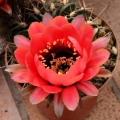
by Valentino Vallicelli




















